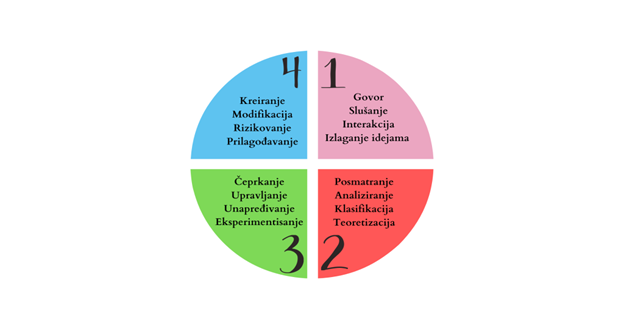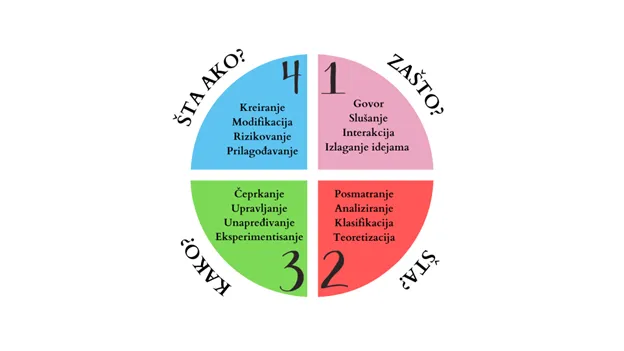
Elevate Your Presentation Game: Techniques for Taking Your Presentations to New Heights
Public speaking is a common source of fear and discomfort for many individuals. Even those who relish being on stage and engaging with audiences cannot deny the goosebumps and stomach trembles that precede each performance in front of a group.
However, a proven way to alleviate these feelings of tension and nervousness is to ensure complete confidence in your message and presentation preparation. In the following paragraphs, you will discover a range of techniques to enhance your public speaking skills.
4MAT system
By following the 4MAT system in four simple steps, you can elevate your presentations and leave your audience applauding at the end. Bernice McCarthy developed this system based on a study of learning styles.
It emphasizes increased engagement and interaction from the listeners, which is precisely why you are presenting. At the pinnacle of this system is the implementation of knowledge in real-life situations for your listeners, leaving you with a sense of gratitude and an invitation for future presentations.
Learning styles (by Bernice McCarthy)

The results of this and other related studies reveal various categories of learning styles. Familiarizing yourself with these styles can enhance your understanding of the structure and benefits of the 4MAT system.
1. The Innovative Learning Style
Individuals with an innovative learning style seek answers to the question "Why is it important that I know this?"
They require a purpose for their learning and find it engaging when problems connect to real-life scenarios where the knowledge they acquire will be useful.
These learners process information through their senses and emotions. They are curious and inquisitive, ask questions, discuss personal feelings, and thrive in group settings.
2. The Analytical Learning Style
Individuals with an analytical learning style are most efficient at acquiring knowledge through facts, ideas, and details. They often ask the question, "What do I need to know?"
These learners are always prepared and eager to gain knowledge and are typically well-organized.
They process information through thinking and reasoning.
3. The Common-Sense Learning Style
Individuals who learn through the common-sense style prefer active problem-solving and seek to understand "How can I use this information?"
These hands-on learners enjoy tactile activities, constructing, discovering, and managing. Practical experience is essential to their learning process as they strive to apply newly acquired knowledge to real-life situations.
They process information through active thinking, contrasting the reflective processing of the analytical learning style.
4. The Dynamic Learning Style
Individuals with a dynamic learning style crave action and prefer to learn through physical engagement, utilizing all their senses. They often ask the question, "What if?"
These learners do not enjoy limitations, so they excel in tasks with no specific timeframe for their solution. They are willing to take risks to achieve their goals.
These learners process information concretely, actively utilizing all their senses to engage with the material.
4MAT Presentation Model

An ideal presentation should satisfy each of the previously mentioned learning styles in the following order:
1. WHY?
Begin your presentation with the why type of learner, as they need to understand the purpose behind the material before they can engage with it. Until you explain the why, individuals with this learning style won't pay attention to what you're saying, as they need to know why they should be interested.
Addressing their needs first is crucial to avoid alienating them.
Tip: To capture your audience's attention, start with an attention-grabbing title. At the beginning of your presentation, convince them that your content is worth listening to by explaining why it is important.
2. WHAT?
It is best to provide a concise explanation of what your presentation is actually about. Participants need detailed information about the topic and where they can apply it. This will allow them to delve deeper into the subject matter.
Tip: This is the perfect moment to keep their attention and further engage them. Be clear and thorough when you speak, and avoid repeating what has already been said.
3. HOW?
Next, address the question of how.
During training or workshops, this can be best accomplished through specific activities and exercises. During a presentation, explain how the information can be applied in everyday business situations or other contexts relevant to the audience.
Visual aids, such as diagrams, mind maps, and graphics, are useful in conveying this information.
Tip: anticipate potential questions from those new to the topic and address them throughout your presentation to provide a comprehensive understanding of the subject matter.
4. WHAT IF?
Addressing the question of what if is important to show the consequences through certain scenarios, such as:
What happens if they use what you present and talk about, and what happens if they don't? What will happen if they don't follow the plan, and what if they do?
Tip: The answer to this question can also relate to what you want them to do after the presentation. Be clear and explicit in your call to action, targeting your audience appropriately. If you don't communicate it effectively, you risk missing the desired impact.
Simplicity is your friend
The 4MAT system's biggest advantage is its simplicity. It makes it easier for you to conceive and organize your presentation and allows participants to easily follow and apply what they have learned. Embrace it!
Warning: Undefined variable $post in /var/www/html/wp-content/plugins/oxygen/component-framework/components/classes/code-block.class.php(133) : eval()'d code on line 2
Warning: Attempt to read property "ID" on null in /var/www/html/wp-content/plugins/oxygen/component-framework/components/classes/code-block.class.php(133) : eval()'d code on line 2

